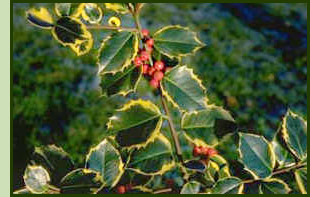 |
||||
|
|
 |
|
||
|
|
||||
|
Q: My holly looks different than my
neighbors. Why? A: Your neighbor may have a different species. There are approximately 175 species of holly in the world. These differ in shape of leaves and size and shape of plant, among other attributes. Only a few species are used commercially in the United States and Canada. They are primarily English holly, (Ilex aquifolium), grown in Washington, Oregon and British Columbia, and the Native American holly (Ilex opaca) which grows along the Atlantic coast. Q: What kinds of holly are found in the Pacific Northwest? A: While several of the 175 species may be found in special situations, commercial Northwest Holly Growers normally offer a choice of variegated or green English holly. The variegated holly has cream around the edges with green centers and the green holly is a rich shiny green. Chinese(Ilex cornuta), and Japanese(Ilex crenata) hollies- which are shrubs, not trees- are grown by commercial nurseries for landscaping plants.  Q: What is the difference between variegated and English holly? A: There is no difference. Variegated holly is just one variety of English holly. Q. I have a beautiful green holly tree, but it has no berries. Why not? A. There are several possibilities. One is that it is a male tree. These have flowers, but do not set berries. The other is that it is a female tree, but there are no males of the same species around to pollinate it. Yet another is that the tree has a health problem relating either to nutrients or pests. Q. Are holly berries poisonous? A. NO. Birds and animals count on holly to provide food during the winter months. For humans, the berries will taste bitter and may cause an upset stomach or act as a mild laxative, if enough are ingested. While health benefits of holly are elusive, significant health harms have not been documented. . On the contrary, it is a perfect indoor decoration for people with allergies, as it contains no dust, pollens, or fragrances. Q. How can I use holly for decoration? A. Use your imagination. Holly has survived for many centuries as a festive icon. It has always been arranged in bowls, baskets or vases. It is also used alone in wreaths or with other greenery. Holly looks lovely with red carnations in February, with daffodils in March, with tulips in May, and at Thanksgiving with pumpkins and grapes. The combinations are endless, because it is so versatile. Q. I am hearing some claims that holly is invasive. Is this true? A.. NO. The USDA National Invasive Species Information Center considers invasive species as those that are non-native and which harm the environment, the economy or human health. While English holly (Ilex aquifolium) is non-native to North America, it is not clear that it causes any harm to the environment. There are many holly farmers who earn income from selling beautiful decorative holly products throughout the country, which is a boon to the Pacific Northwest economy. The claim of holly being invasive has no basis in fact. Q. Is this “tree of winter” a threat to our forests? A. NO. Holly cannot thrive in our native forests because it is shade intolerant and cannot compete in a dense forest environment. Volunteer holly, seeded by birds, are almost always male trees that will not reproduce. Holly is non-native to North America, but there is no documentation that it will dominate our forests, such as Himalayan blackberry and Scotch Broom have done in the Pacific Northwest. Q. When did holly first arrive in the Pacific Northwest? A. Records show that English holly (Ilex aquifolium) was first planted in 1874 in Portland, OR and in Puyallup, Washington in 1891. Commercial sales from these trees began about 1898. Q. I have been trying to grow some variegated holly from berries, but they just don't seem to sprout. What am I doing wrong? A. Berries from variegated English holly trees are sterile. The only way to get new variegated trees is by propagation from cuttings. Q. I am seeing dead leaves dropping off my holly tree. I thought holly was evergreen so why are the leaves dropping? A. After several years, old leaves drop off. If the tree has an infestation of disease such as phytopthera (a fungus), leaves may fall off prematurely. |
||||
|
|
||||
|
|
|
|
|
|